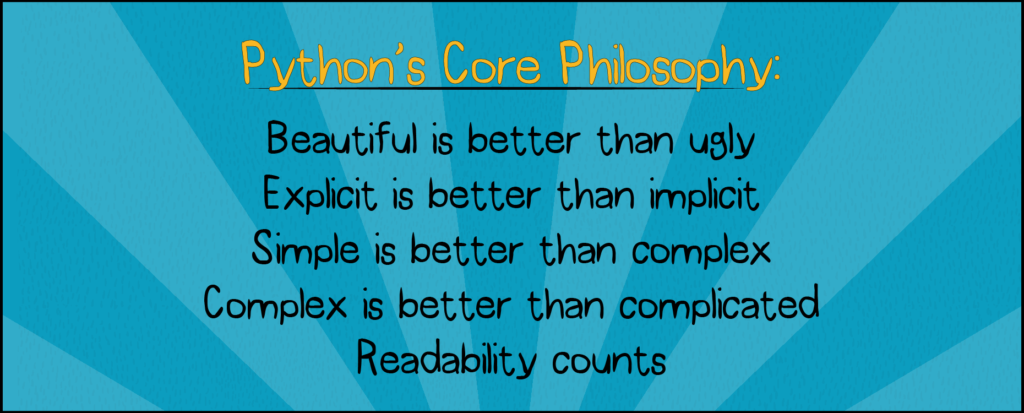Con el lanzamiento del más nuevo de CodeMonkey Curso de Python, Banana Tales, es el momento perfecto para una inmersión profunda en Python para que sepa todo sobre el lenguaje popular antes de enseñárselo a sus alumnos.
¿Qué es Python?
Pitón was developed in 1991 by Dutch programmer Guido van Rossum to meet his vision of an easy and intuitive computer language that could compete with more complicated alternatives. Since then, Python has proven to be a widely-used coding language that sets itself apart. Rossum was an innovator in his vision of creating a text-based programming language that’s not only useful but also easy to learn and implement.
¿Por qué Python es tan popular?
With libraries of ready-made code, English-like mechanisms, and broad uses, Python remains a clear choice for many developers.
De código abierto: Python has proven itself as one of the most-used programming languages largely because it is open-source. Since anyone can contribute to the development of Python, programmers can import libraries with ready-made code to create programs more efficiently.
Sintaxis fácil: The way Python code is written is fairly similar to English, making it almost as easy to understand as the spoken language. Python is formatted with a clean, streamlined design as it does not have many punctuation marks (i.e., it does not use curly brackets) and special cases as do many other programming languages.
Funcional: Python can be used to create a wide range of programs, making it a popular choice in the real world. You can use it to build games, web browsers, and word processors. Whatever you are interested in building, Python can most likely help you in the process.

¿Qué conceptos de codificación debo conocer?
Antes de presentarles Python a sus alumnos, es una buena idea familiarizarse con los principales conceptos de codificación que se encuentran en Python.
- Variables: These containers store values. Variables can be changed throughout the program. The value in one variable can be copied and stored in another.
- Datos: En Python, los datos pueden incluir números, cadenas (fragmentos de texto) o booleanos (verdadero o falso).
- Entrada y salida: Input and output make up the flow of a program. Input refers to data flowing into the computer such as typed text, files, or mouse clicks. Output refers to data coming out of the computer such as visual, auditory, or tactile information.

- Operadores booleanos: ‘and’ is a command that will be true if both of the operands (x and y) are true. ‘or’ is true if either of the operands is true (x or y).
- Clase: Classes are essentially a template to create your objects. In a class, we will define the object’s properties and methods.
- Condicionales: Conditionals are the decision-makers in the program. You can add code that will run only in certain situations. A conditional statement returns only True or False.
- Bucles: Loops are a great way to write repeating code with efficiency. The ‘for’ loop is a simple loop used to iterate or repeat, over a sequence. A ‘while’ loop continues as long as its condition is met.
- Lista: A list is a structure in Python that keep items in an ordered sequence of items. It is one of the most used data types in Python and is very flexible or mutable, meaning it can easily be changed.
- Cuerda: A string is a sequence of characters surrounded by quotation marks.
- Función: A function is a piece of code that performs a specific task. When a function is “called,” Python retrieves the code for that function and then runs it. After the function is finished, the program runs the next command after that line of code.
- Bibliotecas: In Python, libraries contain codes that were written in previous programs. You can re-use this code in your program for faster development. Python comes with a Standard Library but you can import modules, or sections of a library, to your code to make it more powerful (not covered in Banana Tales).
Para comprender mejor los conceptos anteriores y aprender los entresijos de Python, recomendamos jugar Banana Tales con su clase.
Quiero enseñar Python a los niños. Por donde puedo empezar
Puede comenzar registrándose para una prueba de profesor de CodeMonkey y jugando los primeros 21 desafíos de Cuentos de Bananas. Si desea continuar aprendiendo este versátil idioma, puede comprar Banana Tales para su clase. Además, puede consultar este recurso, which offers some Python learning books.






2 opiniones en “How to Teach Kids Python: All You Need to Know”
¡Este va a ser un programa increíble! No puedo
😀